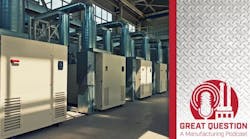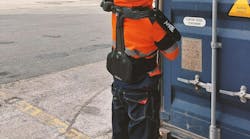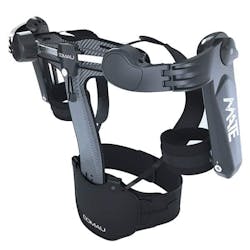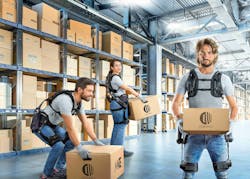The logistics and cargo handling activities carried out in the port environment are largely managed manually by workers to ensure the operational standards are met correctly. To make its employees’ tasks easier, more efficient, and ergonomic, the Port System Authority of the Northern Tyrrhenian Sea, AdSP MTS (Autorità di Sistema Portuale del Mar Tirreno Settentrionale) and the Livorno Port Company, CPL (Compagnia Portuale di Livorno), together with IUVO, a spin-off company of the Scuola Superiore Sant'Anna (Pisa), and Comau have conducted a pilot study for the adoption of wearable MATE-XT and MATE-XB exoskeletons designed by the two companies.
Among the first study of its type to be carried out in Europe and the world, the field tests were carried out over six months with 12 workers employed in the port area of Livorno who wore MATE exoskeletons during their daily work. During this period, the positive effects obtained at both a physical and operational level were measured and validated.
Duilio Amico, CEO of IUVO and Head of Wearable Technologies at Comau, explained, “The study conducted together with important institutions such as AdSP MTS and CPL is one of the first in Europe and in the world that aims to evaluate the effect of exoskeleton technologies for the improvement of ergonomics and safety of workers in the port system. This project confirms IUVO and Comau’s commitment to creating an ecosystem for the development and adoption of wearable robotics technologies that promote the well-being of workers.”
MATE-XT helps to reduce the muscle load of the upper limbs during static or repetitive activities, which require workers to keep their arms raised for extended periods while MATE-XB relieves the muscle effort of the lumbar area when handling loads.
Manual, non-automatable activities such as loading and unloading goods, moving heavy loads along the dock, and lashing or unlashing containers onboard ships can be extremely tiring for operators. The support of exoskeletons helps reduce physical stress and the risk of triggering potentially disabling musculoskeletal diseases over time.
To confirm this, in the initial phase of the project, IUVO and Comau conducted accurate instrumental measurements of the muscle activity of the workers. These same workers were asked, through the compilation of dedicated questionnaires, to directly assess the sensation of fatigue perceived with the use of MATE exoskeletons.
Luciano Guerrieri, President of the Autorità di Sistema Portuale del Mar Tirreno Settentrionale, said, “Safety and the protection of workers’ health are fundamental for our institution. The constant attention to these aspects, combined with openness and interest in innovation, has allowed us to be one of the first port systems in the world to test these cutting-edge technologies, with the aim of reaffirming and improving our commitment to the safety and well-being of our employees.”
The end results have been impressive. Not only did the operators embrace these new technologies, but they also recognized the positive impact the exoskeletons can have on their activities and performance. In line with data previously collected and verified by IUVO and Comau, together with companies that have been using this technology for several years, it has been shown that the MATE-XT upper limb exoskeleton and the MATE-XB lumbar device can reduce the effort of operators by up to 30%.
The pilot study and the positive results achieved testify to the commitment of the AdSP MTS and the CPL in promoting the health and well-being of port operators, as well as in experimenting with cutting-edge technologies capable of making the working environment safer and more comfortable.
Nicola Vitiello, full professor at the Scuola Superiore Sant'Anna and co-founder of IUVO, underscored, “The pilot study launched in Livorno’s seaport was an important opportunity to continue testing and perfecting the wearable robotics solutions developed with Comau directly in the field, in new applications and sectors. The benefits and enthusiasm experienced by those who wear MATE exoskeletons to carry out their tasks are further confirmation of how this innovative technology can be successfully applied in different areas in the future, significantly reducing physical fatigue and improving people’s quality of life.”
Enzo Raugei, Chairman of the Compagnia Portuale di Livorno, added, “The well-being of our workers is central to the Company. We are thrilled to have been at the forefront of implementing innovative technologies in our industry and to have been the first to understand their use in the port business. The safety and well-being of our members and employees is a top priority for our cooperative, and this initiative demonstrates our continued commitment to ensuring it.”
Comau, a Stellantis company, is a leader in delivering sustainable advanced automation solutions. With 50 years of experience and a global presence, Comau is helping companies of all sizes in almost any industry leverage the benefits of automation. Its portfolio includes products and systems for vehicle manufacturing, with a strong presence in e-mobility, as well as advanced robotics and digital solutions to address rapidly growing markets in industrial sectors.
IUVO is a spin-off company of the Istituto di BioRobotica della Scuola Superiore Sant’Anna, in which Comau holds a majority stake. Founded in 2015 by a team of post-doctorate, professors and researchers in the field of industrial robotic devices, it aims to create wearable, smart, and active tools that can improve the quality of life. The enabling technologies developed by IUVO are intended to foster and facilitate human-machine symbiosis.












